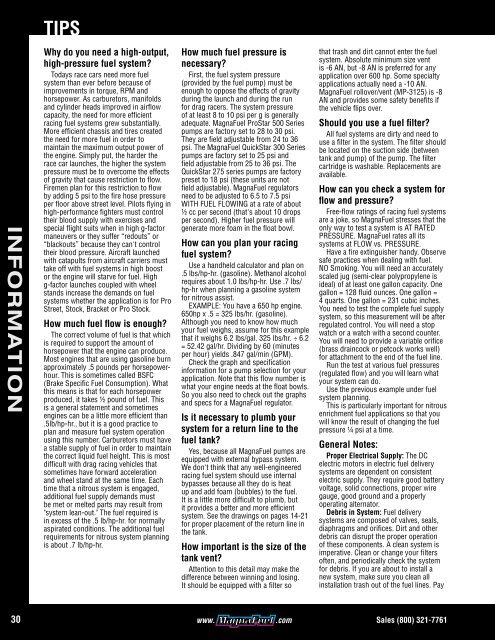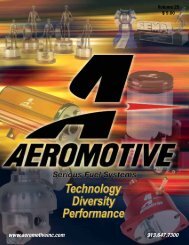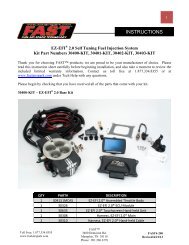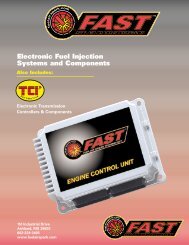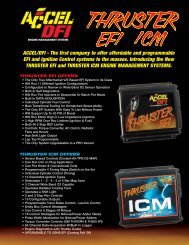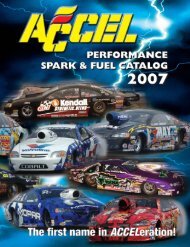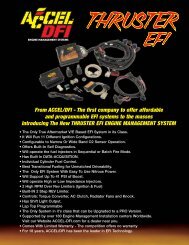Download Catalog - MagnaFuel
Download Catalog - MagnaFuel
Download Catalog - MagnaFuel
Create successful ePaper yourself
Turn your PDF publications into a flip-book with our unique Google optimized e-Paper software.
TIPS<br />
INFORMATION<br />
Why do you need a high-output,<br />
high-pressure fuel system<br />
Todays race cars need more fuel<br />
system than ever before because of<br />
improvements in torque, RPM and<br />
horsepower. As carburetors, manifolds<br />
and cylinder heads improved in airflow<br />
capacity, the need for more efficient<br />
racing fuel systems grew substantially.<br />
More efficient chassis and tires created<br />
the need for more fuel in order to<br />
maintain the maximum output power of<br />
the engine. Simply put, the harder the<br />
race car launches, the higher the system<br />
pressure must be to overcome the effects<br />
of gravity that cause restriction to flow.<br />
Firemen plan for this restriction to flow<br />
by adding 5 psi to the fire hose pressure<br />
per floor above street level. Pilots flying in<br />
high-performance fighters must control<br />
their blood supply with exercises and<br />
special flight suits when in high g-factor<br />
maneuvers or they suffer “redouts” or<br />
“blackouts” because they can't control<br />
their blood pressure. Aircraft launched<br />
with catapults from aircraft carriers must<br />
take off with fuel systems in high boost<br />
or the engine will starve for fuel. High<br />
g-factor launches coupled with wheel<br />
stands increase the demands on fuel<br />
systems whether the application is for Pro<br />
Street, Stock, Bracket or Pro Stock.<br />
How much fuel flow is enough<br />
The correct volume of fuel is that which<br />
is required to support the amount of<br />
horsepower that the engine can produce.<br />
Most engines that are using gasoline burn<br />
approximately .5 pounds per horsepowerhour.<br />
This is sometimes called BSFC<br />
(Brake Specific Fuel Consumption). What<br />
this means is that for each horsepower<br />
produced, it takes 1⁄2 pound of fuel. This<br />
is a general statement and sometimes<br />
engines can be a little more efficient than<br />
.5lb/hp-hr., but it is a good practice to<br />
plan and measure fuel system operation<br />
using this number. Carburetors must have<br />
a stable supply of fuel in order to maintain<br />
the correct liquid fuel height. This is most<br />
difficult with drag racing vehicles that<br />
sometimes have forward acceleration<br />
and wheel stand at the same time. Each<br />
time that a nitrous system is engaged,<br />
additional fuel supply demands must<br />
be met or melted parts may result from<br />
"system lean-out." The fuel required is<br />
in excess of the .5 lb/hp-hr. for normally<br />
aspirated conditions. The additional fuel<br />
requirements for nitrous system planning<br />
is about .7 lb/hp-hr.<br />
How much fuel pressure is<br />
necessary<br />
First, the fuel system pressure<br />
(provided by the fuel pump) must be<br />
enough to oppose the effects of gravity<br />
during the launch and during the run<br />
for drag racers. The system pressure<br />
of at least 8 to 10 psi per g is generally<br />
adequate. <strong>MagnaFuel</strong> ProStar 500 Series<br />
pumps are factory set to 28 to 30 psi.<br />
They are field adjustable from 24 to 36<br />
psi. The <strong>MagnaFuel</strong> QuickStar 300 Series<br />
pumps are factory set to 25 psi and<br />
field adjustable from 25 to 36 psi. The<br />
QuickStar 275 series pumps are factory<br />
preset to 18 psi (these units are not<br />
field adjustable). <strong>MagnaFuel</strong> regulators<br />
need to be adjusted to 6.5 to 7.5 psi<br />
WITH FUEL FLOWING at a rate of about<br />
1⁄2 cc per second (that's about 10 drops<br />
per second). Higher fuel pressure will<br />
generate more foam in the float bowl.<br />
How can you plan your racing<br />
fuel system<br />
Use a handheld calculator and plan on<br />
.5 lbs/hp-hr. (gasoline). Methanol alcohol<br />
requires about 1.0 lbs/hp-hr. Use .7 lbs/<br />
hp-hr when planning a gasoline system<br />
for nitrous assist.<br />
EXAMPLE: You have a 650 hp engine.<br />
650hp x .5 = 325 lbs/hr. (gasoline).<br />
Although you need to know how much<br />
your fuel weighs, assume for this example<br />
that it weighs 6.2 lbs/gal. 325 lbs/hr. ÷ 6.2<br />
= 52.42 gal/hr. Dividing by 60 (minutes<br />
per hour) yields .847 gal/min (GPM).<br />
Check the graph and specification<br />
information for a pump selection for your<br />
application. Note that this flow number is<br />
what your engine needs at the float bowls.<br />
So you also need to check out the graphs<br />
and specs for a <strong>MagnaFuel</strong> regulator.<br />
Is it necessary to plumb your<br />
system for a return line to the<br />
fuel tank<br />
Yes, because all <strong>MagnaFuel</strong> pumps are<br />
equipped with external bypass system.<br />
We don't think that any well-engineered<br />
racing fuel system should use internal<br />
bypasses because all they do is heat<br />
up and add foam (bubbles) to the fuel.<br />
It is a little more difficult to plumb, but<br />
it provides a better and more efficient<br />
system. See the drawings on pages 14-21<br />
for proper placement of the return line in<br />
the tank.<br />
How important is the size of the<br />
tank vent<br />
Attention to this detail may make the<br />
difference between winning and losing.<br />
It should be equipped with a filter so<br />
that trash and dirt cannot enter the fuel<br />
system. Absolute minimum size vent<br />
is -6 AN, but -8 AN is preferred for any<br />
application over 600 hp. Some specialty<br />
applications actually need a -10 AN.<br />
<strong>MagnaFuel</strong> rollover/vent (MP-3125) is -8<br />
AN and provides some safety benefits if<br />
the vehicle flips over.<br />
Should you use a fuel filter<br />
All fuel systems are dirty and need to<br />
use a filter in the system. The filter should<br />
be located on the suction side (between<br />
tank and pump) of the pump. The filter<br />
cartridge is washable. Replacements are<br />
available.<br />
How can you check a system for<br />
flow and pressure<br />
Free-flow ratings of racing fuel systems<br />
are a joke, so <strong>MagnaFuel</strong> stresses that the<br />
only way to test a system is AT RATED<br />
PRESSURE. <strong>MagnaFuel</strong> rates all its<br />
systems at FLOW vs. PRESSURE.<br />
Have a fire extinguisher handy. Observe<br />
safe practices when dealing with fuel.<br />
NO Smoking. You will need an accurately<br />
scaled jug (semi-clear polypropylene is<br />
ideal) of at least one gallon capacity. One<br />
gallon = 128 fluid ounces. One gallon =<br />
4 quarts. One gallon = 231 cubic inches.<br />
You need to test the complete fuel supply<br />
system, so this measurement will be after<br />
regulated control. You will need a stop<br />
watch or a watch with a second counter.<br />
You will need to provide a variable orifice<br />
(brass draincock or petcock works well)<br />
for attachment to the end of the fuel line.<br />
Run the test at various fuel pressures<br />
(regulated flow) and you will learn what<br />
your system can do.<br />
Use the previous example under fuel<br />
system planning.<br />
This is particularly important for nitrous<br />
enrichment fuel applications so that you<br />
will know the result of changing the fuel<br />
pressure 1⁄4 psi at a time.<br />
General Notes:<br />
Proper Electrical Supply: The DC<br />
electric motors in electric fuel delivery<br />
systems are dependent on consistent<br />
electric supply. They require good battery<br />
voltage, solid connections, proper wire<br />
gauge, good ground and a properly<br />
operating alternator.<br />
Debris in System: Fuel delivery<br />
systems are composed of valves, seals,<br />
diaphragms and orifices. Dirt and other<br />
debris can disrupt the proper operation<br />
of these components. A clean system is<br />
imperative. Clean or change your filters<br />
often, and periodically check the system<br />
for debris. If you are about to install a<br />
new system, make sure you clean all<br />
installation trash out of the fuel lines. Pay<br />
30<br />
www. .com Sales (800) 321-7761


